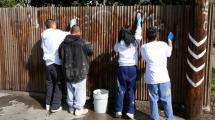Youth who receive special education services under the Individuals with Disabilities Education Act (IDEA 2004) and especially young adults of transition age, should be involved in planning for life after high school as early as possible and no later than age 16. Transition services should stem from the individual youth’s needs and strengths, ensuring that planning takes into account his or her interests, preferences, and desires for the future.
Families
Family acceptance and support are significant factors that promote well-being and protection from risks for all youth, including LGBTQ+ youth.1 The meaning of “family” varies by personal, cultural, and other factors and can include individuals who are not biologically or legally related to a youth (i.e., families of choice).2
Family acceptance, along with strong parent-child attachment, has been found to be critical to LGBTQ+ youth’s ability to “successfully navigate stigma, isolation, and bullying.”3 Family acceptance of LGBTQ+ youth through understanding and appropriately and positively responding to their experiences and needs is a strong protective factor for the youth in successfully transitioning to adulthood.
Therefore, it is important for families to express support through:
- talking openly with youth about their LGBTQ+ identity in an affirming manner
- communicating that their young person can have a happy future as an LGBTQ+ adult
- welcoming the youth’s LGBTQ+ friends and supporting their involvement in LGBTQ+ youth groups
- working to ensure that other family members respect the young person
- talking with clergy and help their faith community support LGBTQ+ individuals
- responding positively to the youth’s gender expression including hairstyle, dress, and appearance
- advocating for youth if they are mistreated because of their identity4
It is also important for youth-serving agencies and communities to enhance their cultural competence in working with LGBTQ+-headed families, which are increasing in number.5 Youth who are not LGBTQ+ but have an LGBTQ+ caregiver may also experience bias and other negative outcomes because of reactions to their caregiver’s LGBTQ+ identity.
Youth-serving organizations and systems can build awareness about and encourage family behaviors that research has shown can affect outcomes for LGBTQ+ youth. Examples of behaviors that should be avoided and discouraged include:
- blocking access to LGBTQ+ friends, events, and resources
- blaming youth when they are discriminated against because of their LGBTQ+ identity
- pressuring youth to be more (or less) “masculine” or “feminine”
- pressuring youth to keep their LGBTQ+ identity a “secret”6
Although some families are supportive, accepting, and even celebratory, others may respond and behave in ways that have negative consequences and result in trauma to the youth. In 2021, The Trevor Project surveyed nearly 35,000 LGBTQ youth ages 13-24 across the United States7 and found that only 1 in 3 LGBTQ youth surveyed found their home to be LGBTQ-affirming.8 Research demonstrates a strong link between family rejection of LGBT youth and negative physical and mental health outcomes for them, including being a risk factor for suicide.9
Resources
Family Acceptance Project
This community research, intervention, and education initiative studies the impact of family acceptance and rejection on the health, mental health, and well-being of youth who are LGBTQ. The project’s results are the basis for resources to help families provide support for youth who are LGBTQ. The project provides appropriate interventions, programs, and policies and will train providers to improve the quality of services and care that youth who are LGBTQ receive.
getREAL (Recognize. Engage. Affirm. Love)
This initiative promotes the healthy development of all children and youth, with a focus on sexual orientation, gender identity, and expression. getREAL challenges public systems working with children and youth to improve their policies and practices to support the healthy sexual and identity development of all children and youth in child welfare systems.
A Practitioner's Resource Guide: Helping Families to Support Their LGBT Children (PDF, 18 pages)
This guide offers information and resources to help practitioners throughout health and social service systems implement best practices in engaging and helping families and caregivers to support their LGBT children.
Resources for LGBT Youth and Friends/Supporters, and Parents, Guardians and Family Members
This webpage provides many resources for LGBT youth and friends, such as a communication tool to empower LGBT youth to become actively engaged in their health, and supportive organizations such as The Trevor Project and It Gets Better. There are also resources for parents, guardians, and family members to learn how to be supportive of LGBT youth, including fact sheets (PDF, 3 pages), guides (PDF, 18 pages), and organizations like the Family Acceptance Project.
References
1 Poirier, Fisher, Hunt, & Bearse, 2014
2 Poirier, Fisher, Hunt, & Bearse, 2014
3 Katz-Wise et al., 2016
4 Ryan, 2009; Ryan, 2010
5 Krivickas & Lofquist, 2011; For more information see the UCLA Williams Institute Census and Demographics LGBT Studies
6 SAMHSA, 2014
7 45 percent of this sample were youth of color, and 38 percent were transgender or nonbinary.
8 The National Trevor Project, 2021
9 Ream & Forge, 2014
Other Resources on this Topic
Announcements
Briefs
Collaboration Profiles
Data Sources
Feature Articles
Publications
Resources
Technical Assistance
Tools & Guides
Videos & Podcasts
Websites
Youth Topics
Youth Briefs
Research links early leadership with increased self-efficacy and suggests that leadership can help youth to develop decision making and interpersonal skills that support successes in the workforce and adulthood. In addition, young leaders tend to be more involved in their communities, and have lower dropout rates than their peers. Youth leaders also show considerable benefits for their communities, providing valuable insight into the needs and interests of young people
Statistics reflecting the number of youth suffering from mental health, substance abuse, and co-occurring disorders highlight the necessity for schools, families, support staff, and communities to work together to develop targeted, coordinated, and comprehensive transition plans for young people with a history of mental health needs and/or substance abuse.
Nearly 30,000 youth aged out of foster care in Fiscal Year 2009, which represents nine percent of the young people involved in the foster care system that year. This transition can be challenging for youth, especially youth who have grown up in the child welfare system.
Research has demonstrated that as many as one in five children/youth have a diagnosable mental health disorder. Read about how coordination between public service agencies can improve treatment for these youth.
Civic engagement has the potential to empower young adults, increase their self-determination, and give them the skills and self-confidence they need to enter the workforce. Read about one youth’s experience in AmeriCorps National Civilian Community Corps (NCCC).






